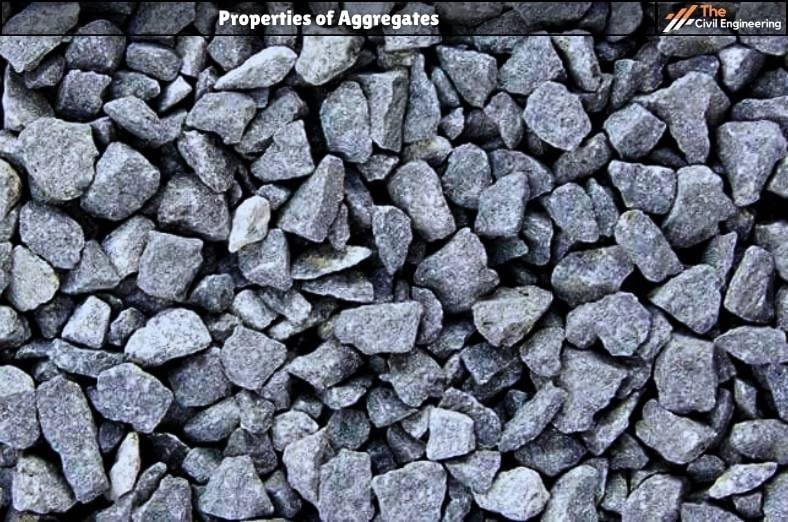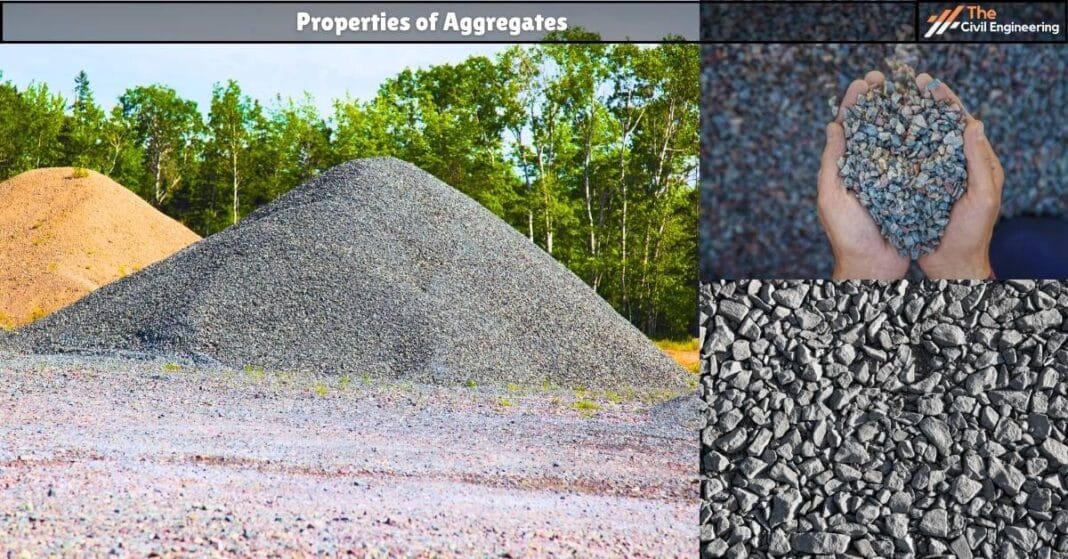1. Introduction
Aggregate is a collective term for the mineral materials such as gravel, sand, and crushed stone, which are used along with binding materials such as bitumen, cement, lime, etc to form compound materials. Properties of aggregate play a vital role in the strength and durability of structures. So we are discussing the properties of aggregates used for :
a. Road
b. Concrete

2. Properties of Aggregates Used in Roads
Aggregates used in road construction should have the following properties:
a. Strength:
The aggregate to be used in road construction should be sufficiently strong to withstand crushing and several stresses due to traffic wheel load.
b. Hardness:
The aggregates used in the surface course are subjected to rubbing or abrasion. So, the aggregate should be hard enough to resist wear and tear due to the abrasive action of traffic.
c. Toughness:
Resistance to impact is termed as toughness.
Aggregates used in the pavement are also subjected to impact due to moving wheel loads and hammering action due to jumping of tires.
Hence, toughness is another desirable property of road aggregate.
d. Soundness/Durability:
The property to withstand adverse action of weather or the ability to remain strong over a long period is called durability or soundness.
Aggregates are subjected to the physical and chemical action of rain and groundwater.
Hence, aggregate should be durable to withstand weathering action.
e. Shape of aggregate
Aggregates may be of different shapes such as cubical, rounded, flaky, elongated, etc.
Flaky and Elongated aggregates have lower strength.
So, generally round and angular are preferred.
f. Adhesion with bitumen
Adhesion simply means a binding property with other materials.
So, aggregate should have proper or good binding properties with bitumen/asphalt/tar.
g. Free from foreign particles
Foreign materials like dust, chemicals, etc reduce the binding property of aggregate i.e. adhesion between aggregate and bitumen is reduced.
So, the material should be free from foreign materials.
3. Properties of Aggregates Used in Concrete
Aggregates used in the concrete should have the following properties:
a. Composition
Aggregate should be free from materials that react with alkalies in cement because it may lead to cracking, excessive expansion, and deterioration of concrete mix.
So, several tests should be carried out to ensure the presence of such materials before use.
b. Size & Shape
The size and shape of aggregates directly influence the quantity of cement required in concrete mix and hence ultimately the economy of concrete.
Largest coarse aggregates should be given priority according to the feasibility of structure.
According to IS-456; the maximum size of aggregates that can be used in PCC and RCC are:
a.1/4 th of the minimum dimension of the concrete member.
b. 1/5 th of the minimum dimension of the reinforced concrete member.
c. Surface Texture
Proper bonding of aggregate with concrete depends upon surface texture, surface roughness and porosity.
When the surface of aggregate is rough and porous, it provides maximum strength and good bonding to concrete.
Cement paste in concrete set inside the pores of aggregate which provides very strong bonding.
d. Specific Gravity
The ratio of the weight of oven-dried aggregates maintained for 24 hours at a temperature of 100 to 1100C, to the weight of the equal volume of water displaced by saturated dry surface aggregate is known as the specific gravity of aggregates.
Lower specific gravity indicates porous and weak materials and high specific gravity indicates strong and durable materials.
The value of specific gravity should lie between 2.6 to 2.9. The specific gravity also plays a vital role in the concrete mix design.
Table: Specific gravity of materials
| Specific Gravity | |
| Trap | 2.9 |
| Granite | 2.8 |
| Gravel | 2.66 |
| Sand | 2.65 |
e. Bulk Density
Bulk density is the weight of the aggregate required to fill a container of unit volume. Its unit is kg/liter.
Bulk density of aggregate depends upon:
a. The shape of aggregate
b. Grading of the aggregate
c. Degree of the compaction
Table: Value of bulk density
| Bulk Density | |
| River sand | |
| Fine | 1.44 |
| Medium | 1.52 |
| Coarse | 1.60 |
| Beach or river shingle | 1.60 |
| Broken stone | 1.60 |
| Stone screenings | 1.44 |
| Broken Granite | 1.68 |
f. Voids
Tiny empty space between particles of aggregates is called void.
Voids between aggregate particles should be less because excessive voids lead to porous concrete.
Table: Average Void Percentage
| Average Void Percentage | |
| River sand | |
| Fine | 43 |
| Coarse | 35 |
| Mixed and moist | 38 |
| Mixed and dry | 30 |
| Broken stone, graded | |
| 25 mm maximum size | 46 |
| 50 mm maximum size | 45 |
| 63 mm maximum size | 41 |
| Stone screenings | 48 |
g. Impact Value
Aggregate should be resistive towards shock and impact.
Impact value gives the resistive value of aggregate towards crushing.
Higher impact value indicates higher toughness of aggregate.
| Read More: Impact Test of Aggregate |
Table: Values for mechanical properties
| Properties | Limiting Values (Percentage) | |
| For Wearing Surfaces | Other Than for Wearing Surfaces | |
| Crushing value | 30 | 45 |
| Impact value | 30 | 45 |
| Abrasion Value (Los Angeles) | 30 | 50 |
| Soundness (Average loss of weight after 5 cycles) | When tested with Na2SO4 | When tested with MgSO4 |
| Fine aggregates | 10 | 15 |
| Coarse aggregates | 12 | 18 |
h. Abrasion Value
Aggregate should be hard enough to resist abrasion. This decreases the chance of wear and tear in concrete.
| Read More: Abrasion Test |
i. Crushing Value
The crushing value gives the resistance of an aggregate to crushing under the application of compressive load.
j. Deleterious Materials
Aggregate should be free from deleterious materials such as clay, silt, dust, salt contamination, organic materials, etc. because these materials weaken the bond.
k. Surface Water
Coarser aggregates carry less water. So coarser aggregates should be used rather than finer according to conditions.
Table: Surface water carried by aggregates
| Aggregates | Approximate Qty of Surface Water | |
| Percent by mass | Ltr./cu.m | |
| Very wet sand | 7.5 | 120 |
| Moderately wet sand | 5.0 | 80 |
| Moist sand | 2.5 | 40 |
| Moist gravel or crushed rock | 1.25 – 2.5 | 20 – 40 |
| Read More: Properties of Bitumen |
| Read More: Prismatic Compass |


